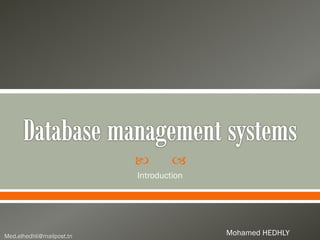Database management systems
•
4 recomendaciones•1,600 vistas
Database management systems (initiation)
Denunciar
Compartir
Denunciar
Compartir
Descargar para leer sin conexión

Recomendados
Recomendados
Más contenido relacionado
La actualidad más candente
La actualidad más candente (20)
Modern-Data-Warehouses-In-The-Cloud-Use-Cases-Slim-Baltagi

Modern-Data-Warehouses-In-The-Cloud-Use-Cases-Slim-Baltagi
Destacado
Destacado (8)
Why is data independence (still) so important? Optiq and Apache Drill.

Why is data independence (still) so important? Optiq and Apache Drill.
Similar a Database management systems
Similar a Database management systems (20)
Week 2 Characteristics & Benefits of a Database & Types of Data Models

Week 2 Characteristics & Benefits of a Database & Types of Data Models
Data Models [DATABASE SYSTEMS: Design, Implementation, and Management]![Data Models [DATABASE SYSTEMS: Design, Implementation, and Management]](data:image/gif;base64,R0lGODlhAQABAIAAAAAAAP///yH5BAEAAAAALAAAAAABAAEAAAIBRAA7)
![Data Models [DATABASE SYSTEMS: Design, Implementation, and Management]](data:image/gif;base64,R0lGODlhAQABAIAAAAAAAP///yH5BAEAAAAALAAAAAABAAEAAAIBRAA7)
Data Models [DATABASE SYSTEMS: Design, Implementation, and Management]
Último
https://app.box.com/s/7hlvjxjalkrik7fb082xx3jk7xd7liz3TỔNG ÔN TẬP THI VÀO LỚP 10 MÔN TIẾNG ANH NĂM HỌC 2023 - 2024 CÓ ĐÁP ÁN (NGỮ Â...

TỔNG ÔN TẬP THI VÀO LỚP 10 MÔN TIẾNG ANH NĂM HỌC 2023 - 2024 CÓ ĐÁP ÁN (NGỮ Â...Nguyen Thanh Tu Collection
Mehran University Newsletter is a Quarterly Publication from Public Relations OfficeMehran University Newsletter Vol-X, Issue-I, 2024

Mehran University Newsletter Vol-X, Issue-I, 2024Mehran University of Engineering & Technology, Jamshoro
Último (20)
ICT role in 21st century education and it's challenges.

ICT role in 21st century education and it's challenges.
Unit-IV; Professional Sales Representative (PSR).pptx

Unit-IV; Professional Sales Representative (PSR).pptx
HMCS Max Bernays Pre-Deployment Brief (May 2024).pptx

HMCS Max Bernays Pre-Deployment Brief (May 2024).pptx
Micro-Scholarship, What it is, How can it help me.pdf

Micro-Scholarship, What it is, How can it help me.pdf
Python Notes for mca i year students osmania university.docx

Python Notes for mca i year students osmania university.docx
Unit-V; Pricing (Pharma Marketing Management).pptx

Unit-V; Pricing (Pharma Marketing Management).pptx
TỔNG ÔN TẬP THI VÀO LỚP 10 MÔN TIẾNG ANH NĂM HỌC 2023 - 2024 CÓ ĐÁP ÁN (NGỮ Â...

TỔNG ÔN TẬP THI VÀO LỚP 10 MÔN TIẾNG ANH NĂM HỌC 2023 - 2024 CÓ ĐÁP ÁN (NGỮ Â...
Food safety_Challenges food safety laboratories_.pdf

Food safety_Challenges food safety laboratories_.pdf
Database management systems
- 2. Presentation Examples Characteristics Data independence • • Data models • • • • Physical independence Logical independence Hierarchical model Network model Relational model Object-oriented model Data architecture • • • External level Logical level Internal level
- 3. Database management systems is a software package that allows users to create, edit, query, update and administrate Database it also defines rules to validate and manipulate this data. Using DBMS final users can simply store modify extract information from database.
- 7. Data independence is a form of database management that keeps data separated from all programs that make use of it. Data cannot be redefined or reorganized by any of the programs that make use of it. In this manner, the data remains accessible, but it is also stable and cannot be corrupted by the applications
- 8. It is the ability to change the internal schema(Using new storage media, Using different data structures, switching from one access method to another, using different file organizations or storage structures, modifying indexes, ...) for reasons of optimization or reorganization without affecting the application programs.
- 9. Logical data independence makes it possible to change the structure of the data(addition or deletion of fresh entities, attributes or relationships... ) independently of modifying the applications or programs that make use of the data.
- 11. It’s a collection of concepts, rules and tools for the description of the structure of the database. Structure of the database means the data types, the data semantics, the constraints and the relationships for the description or storage of data respectively.
- 12. The hierarchical data model organizes data in a tree structure each entity has only one parent but can have several children . At the top of hierarchy there is only one entity which is called Root.
- 13. In the network model, entities are organized in a graph, in which some entities can be accessed through several path The network model organizes data in a tree structure but allows each record to have multiple parent and child records
- 14. A relational database allows the definition of data structures, storage and retrieval operations and integrity constraints. the data and relations between them are organized in tables. A table is a collection of records and each record in a table contains the same fields.
- 15. Object-oriented models define a database as a collection of objects with features and methods. information is represented in the form of objects as used in object-oriented programming
- 17. Models, policies, rules or standards that govern which data is collected, and how it is stored, arranged, integrated, and put to use in data systems and in organizations The architecture of a database system determines its capability, reliability, effectiveness and efficiency in meeting user requirements. A database management system provides three views of the database data:
- 18. The highest level of abstraction it define and specify user views : views that enable different data users to see it in different ways It also contains the method of deriving the objects in the external view from the objects in the conceptual view.
- 19. The next-higher level of abstraction describes what data are stored in the database, and what relationships exist among those data. It defines how information is arranged within the database. the conceptual schema describes all relations that are stored in the database
- 20. The lowest level of abstraction It describes how the data will be physically stored and accessed, using a DBMS. So it describes details of how data is stored: files, indices, etc. on the random access disk system. It also typically describes the record layout of files and type of files
